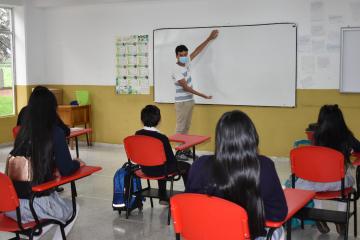
Facing an educational Covid earthquake: An example of scaling up and innovating in Chile

Educational systems around the world are in a precarious position. Regardless of what happens with the new variants of Covid-19, our children’s educational process was substantially interrupted. Despite the tenacious efforts of educational communities and families, there is evidence that the negative consequences on educational achievement, socialization, emotional development, and mental and physical health are large and will persist for a while.
Fortunately, scientific evidence can throw us a line. In the past years, researchers have been investigating the most effective approaches to improving learning outcomes. The strategies are numerous: reducing the costs of participating in school, tailoring the instruction to the individual educational needs, fostering early childhood stimulation, supporting students’ health, and many others. Now we must make use of the available research. How can we translate this knowledge into concrete policies?
A collaborative learning process
Ideally, creating education policies should be a learning process involving close collaboration between researchers, schools, civil society, and policymakers. The first step of the process is to identify a priority issue, carefully diagnose the underlying problem, and review the existing evidence that relates to the topic. Then, taking into account the specific context and constraints, the parties design a program and define how they will evaluate it.
Finally, once the intervention is implemented, the policymakers and researchers should analyze the results and share with others what they learned. In this manner, others can build on the evidence that was just generated and those programs that proved effective can be replicated or scaled up in new contexts.
Last year, amid school closures, we went through this collaborative learning process in Chile. After a commission composed by members of the government, civil society, and academia identified school dropouts as one of the main challenges in education, we decided to build on a simple but powerful premise: Students will stay in the educational system as long as they find it a valuable experience, so we should make sure that they are aware of the benefits of education.
Adapting a program to a new context
There is ample evidence stating that students can make better decisions regarding how much effort they spend on education if they and their parents are informed of the benefits, costs, and quality of education. With this in mind, together with the Chilean Ministry of Education, the NGO ConsiliumBots, and J-PAL LAC, we developed, adapted, and piloted the program “Deciding for a Better Future” (DFM Chile).
This program seeks to increase school retention and improve students’ decisions by providing information on the value and benefits of completing high school, advising on higher education paths and how to fund them, and helping to plan for the future.
DFM Chile builds on similar programs that were implemented in the Dominican Republic and Peru. These programs relied on short relatable “telenovela”-style videos and infographics to help make the information more user-friendly and appealing. Given the positive findings from impact evaluations, they were scaled up at a national level in both countries, and an interdisciplinary panel summoned by the World Bank identified them as examples of public policies that allow improvements in education at low cost.
However, unlike these projects, in which the contents were transmitted in person, we adapted the pilot to the current context in Chile and carried it out on an interactive digital platform run on smartphones, tablets, and laptops. Each week over the course of five weeks under the guidance of their teacher, students watch videos, answer questions, and complete activities, and they even sketch a plan for their future careers.
Having the program in a digital format is not only relevant for the current Covid-19 context but allows to give feedback to the students and track their progress. But what is probably more relevant, if the program has good results, scaling it up would have a much lower marginal cost than if it was scaled up as an in-person initiative.
Early results
The study is still ongoing, but we already observed some interesting results that make DFM a good candidate for a scale-up:
- The digital format makes it easier to scale up the program and extend it to hard-to-reach populations at low marginal costs. In addition, the program could be carried on even when students and teachers had to stay at home due to Covid-19.
- Schools seemed to like the online version of DFM. Around 100 schools, 10,800 students, and 630 teachers had access to the program. The take-up rate among schools was 73 percent—much higher than the 33 percent reached in the first year in Peru—and 7,474 students accessed the platform at least once.
- There are relevant information gaps, regarding the benefits of education and how to pursue and fund higher education, that could be shortened by the program.
- Initial evidence suggests that the intervention changed the beliefs of students regarding the supply of funding for higher education and expected returns, especially to higher education.
Embracing continual learning
Now that the pilot is over, we are eager to analyze and share the results. This will not only help others to build new programs, but it will also allow us to continue the aforementioned learning cycle: By perfecting DFM and further testing it (which we will continue doing next year with a target population of 150,000 students in Chile), we will keep improving educational outcomes as well as producing new evidence.
DFM is a good example of how close work between academia, schools, and policymakers can generate creative and low-cost solutions adapted to the local context. This approach is relatively new in the world of educational policy, where systemic changes are often made before testing and calibrating interventions to local educational realities.
We hope that this way of working will become more frequent and that we improve education as we learn something ourselves. The current educational situation pushes us to act fast, but also to act in a coordinated and smart manner. We need action to be driven by evidence.
DFM was made possible with support from the Tinker Foundation and J-PAL's Innovation in Government Initiative.

